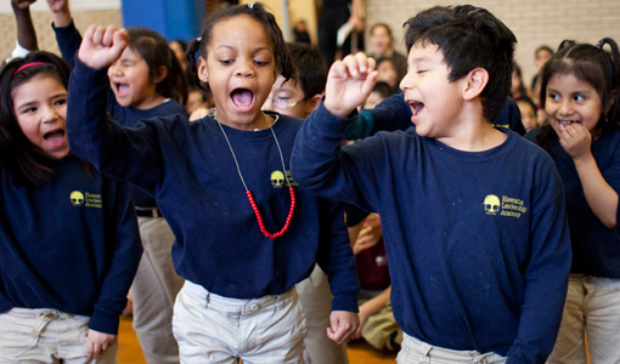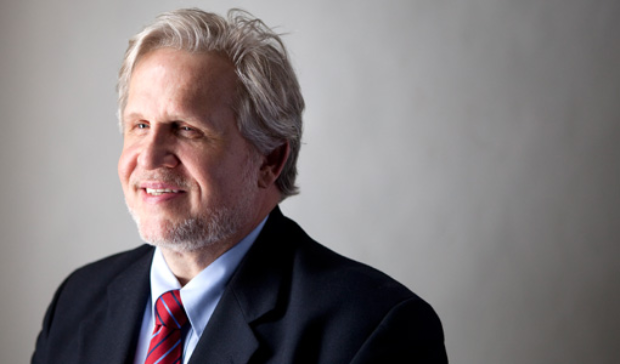It’s Friday afternoon, and the students at Hiawatha Leadership Academy are filing into the gymnasium for an assembly. Their shirts sport the year they will graduate from high school: Class of 2019, Class of 2020, Class of 2021. A teacher calls each class by its mascot – Wolverines, Badgers, Ducks. “Let’s hear from the Oles!” she cries. A group of children, mostly Hispanic and black, stand up and cheer “Um yah yah!” From day one, all of these children know they are expected to go to college. In Minnesota, which has the second highest achievement gap in the nation, that is a tall order, but everyone associated with HLA is determined to succeed.
The achievement gap is the difference in academic measures among racial groups. According to a study by the Editorial Projects in Education Research Center, Minnesota had the ninth highest graduation rate in the United States in 2005. The state’s strong standing came from its white students, who graduated at a rate of 83.3 percent versus 77.6 percent nationwide. Black and Hispanic students lagged far behind. Nationally, 55.3 percent of black students and 57.8 percent of Hispanic students graduated. In Minnesota, the rates were 38.8 percent and 41.9 percent, respectively. Minnesota also had lower than average graduation rates for American Indians and for Asians and Pacific Islanders.
The Opus College of Business has worked with HLA since before the Minneapolis charter school opened in 2007. Two of the school’s founders spoke with Dean Christopher Puto about providing the opportunity for underprivileged youth to achieve an educational foundation for success. When he referred them to St. Thomas’ School of Education, they said, “We’re aware of and impressed by that school, but we already have solid educators behind this. This is an entrepreneurial venture.We need the skills to guide the school and get it up and running.”
That clicked with Puto, and he knew just whom to tap. Dr. John McVea, assistant professor of entrepreneurship, had expressed an interest in social entrepreneurship. He eagerly agreed to assist and now serves on HLA’s board of directors. “I have watched in amazement as Hiawatha Leadership Academy has gone from concept to plan to reality. We're proud that St. Thomas has played a role. We’re even more proud of the impact of John McVea in epitomizing social entrepreneurship,” Puto said. This spring, McVea is using HLA as a case study in the first social entrepreneurship class to be offered by the Opus College of Business.
Social entrepreneurs are defined as “enterprising individuals who apply business practices to solving societal problems such as pollution, poor nutrition and poverty” in BusinessWeek’s 2009 list of “America’s Most Promising Social Entrepreneurs.” These individuals – and organizations – include nonprofits, such as microfinance loan site Kiva, and businesses, such as organic yogurt company Stonyfield Farms. HLA’s approach to education is similarly strategic and innovative as it sets out to achieve its mission: All Hiawatha Leadership Academy scholars will be empowered with the knowledge, character and leadership skills to graduate from college and serve the common good.
All Hiawatha Leadership Academy scholars will be empowered with the knowledge, character and leadership skills to graduate from college and serve the common good.
Some of the thought behind HLA was inspired by KIPP, the Knowledge is Power Program, which consists of 82 public schools in 19 states and the District of Columbia. Students in KIPP schools are primarily low income, and more than 80 percent of students who complete eighth grade at a KIPP school attend college. Among the ideas that HLA has borrowed from KIPP are more classroom time, including a longer school day and a longer school year, and an emphasis on measuring results. All HLA students are tested in September and June, and teachers are rewarded based on their pupils’ performance. Even the physical education teacher benchmarks fitness levels and sets goals for each student.
Unlike the majority of KIPP schools, which are middle schools, HLA starts with an elementary school. Its founders believe that it is better to start working with disadvantaged students when they are young, rather than help them catch up later. Indeed, when they enter kindergarten, most HLA students are underprepared for school. Many do not come from English-speaking homes and have never attended preschool. Few have computers in their homes.
HLA’s hard work seems to be paying off. Test data from September 2008 to May 2009 show that reading scores progressed from the 20th percentile to the 40th percentile, and math scores jumped from the 20th percentile to the 49th percentile. More work is necessary for the students to be college-ready, but they are on their way.
HLA also emphasizes values education, in keeping with its mission to empower its students not only with knowledge but also with character and leadership skills. A visitor to the school cannot miss its five core values, which are posted on banners and which form the basis of school rules and culture: honor, excellence every day, always try again, responsibility and team. Distracted children are reminded to honor others by keeping their eyes on the speaker and refraining from chatting or moving around. Teamwork shows up not only among students in the classroom but also among school employees: Principal Shannon Blankenship has no office, because as an active member of the school’s team, he is either walking around the building or accomplishing desk tasks in shared space with other school employees.
St. Thomas students are learning from and contributing to HLA. This year’s social entrepreneurship class, which is open to all undergraduate students, consists of mostly business majors. McVea envisions a class with a broader range of students, learning from organizations such as HLA and bringing their ideas into the work world. “I would like to see peace and justice majors wrestling over issues with business majors,” he said.
Many St. Thomas students learned about HLA in fall 2007 when McVea made a presentation about the school to Students in Free Enterprise (SIFE), a student organization that uses business knowledge to make a difference through community projects. Mike Warner, a senior majoring in entrepreneurship, remembers, “I liked the idea of an entrepreneurial approach to education.”
Warner volunteered at HLA for a year, but he stopped because he was too busy. During that time, he worked at a valet job. “It brought no fulfillment,” he says. “I was working to park cars faster and make money for my boss and myself. I wanted my work to have a lasting effect.” So he approached Blankenship and asked if he could shadow him. He started with serving lunch and performing administrative tasks. His volunteering blossomed into a job offer. Warner now works part time, 30 to 35 hours per week, as special projects director. He writes grants, helps with the business plan, shovels snow and still serves lunch, among other projects big and small.
Warner finds that his business education is a perfect fit for his HLA job. “Everything I’ve learned, no matter how mundane, has played a role in my job.” Warner reports that his general business classes have helped him work with financial data, while his entrepreneurship classes have helped him approach problems with innovative solutions.
SIFE has brought many other St. Thomas students to HLA, including Dee Kummerfeld ’09, a Spanish and international studies major who was president of SIFE and is a teaching fellow at the school. SIFE members have volunteered with HLA every year since the school opened. This year, they brought the third graders to St. Thomas for an afternoon. They read a children’s book on business ethics developed by SIFE members, led a campus tour and organized a craft project, making mortarboard hats. At the end of the day, the children threw their hats into the air just as they will when they graduate from college.
Ashley Smith, current SIFE president, was impressed by the change she had seen in the lives of children she had met when they were in first grade. “When we read the book on business ethics to them, we asked challenging questions, but the kids got it. They’ve grown.”
SIFE member Kylie Gayan helped SIFE with development activities, among other projects. “I worked with Development at UST,” she reported. “I learned research strategies and how to build a development campaign. You don’t learn that in classes.” She also participated in bringing the third graders to campus and was moved by the children’s response. “At the end of the day, we asked them, ‘How many of you want to go to college even more now that you’ve been here?’ All of them raised their hands. As college students, we’re their role models. That’s one reason we’ll keep going back to volunteer with the school.”
Members of SIFE may be learning new skills as they work to make a difference in the lives of these young students, but they speak more often of the way the school moves them than of what they learn. Senior Renae Pappas said: “I value education and how much of an impact an educator can have on a child’s life a lot more. Knowing about this school, which is so focused on helping each child succeed, inspires me.”
As the number of minority students grows within Minnesota and across the United States, it makes sense to invest in closing the achievement gap.
“If you look at the demographics of our state, these students are likely to be a significant part of the state’s future, and St. Thomas is committed to Minnesota,” Puto noted. He is understandably invested in HLA’s mission, and he believes it will succeed. “I cannot help but be impressed by what goes on at the school. It fulfills every promise.”





